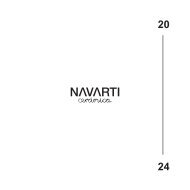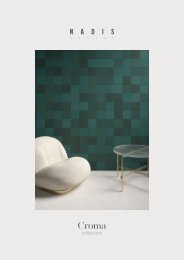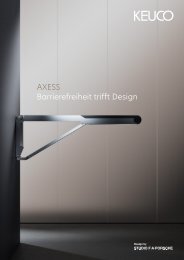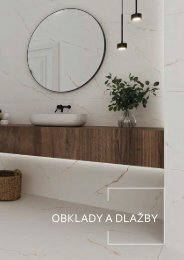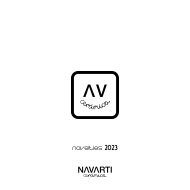navarti infinita_novinky_2023
You also want an ePaper? Increase the reach of your titles
YUMPU automatically turns print PDFs into web optimized ePapers that Google loves.
TRANSPORTE<br />
TRANSPORT<br />
CORTE, PERFORACIÓN Y ACABADO<br />
CUTTING, DRILLING AND FINISHING<br />
El transporte de piezas de gran formato exige varios operarios.<br />
2 3<br />
Será necesario el uso de ventosas y se podrán usar en todas sus va-<br />
riantes (1).<br />
Para piezas con superficie texturizada se recomienda el uso de ventosas<br />
que dispongan de una goma blanda, que garantice la adherencia de las<br />
mismas (2).<br />
1<br />
Para facilitar el manejo y evitar la deformación, se pueden usar barras<br />
de transporte (3).<br />
La solución óptima, consiste en el uso de un bastidor rígido, dotado de<br />
ventosas, que sujete las piezas en todas direcciones sin deformaciones,<br />
posibilitando el transporte con solo dos operarios.<br />
Several workmen will be needed to carry large-format slabs.<br />
Suctions cups will be necessary. Different types can be used (1).<br />
In the case of slabs with a textured surface, soft-rubber suction cups should be used to guarantee a good grip (2).<br />
To handle the slabs more easily and prevent the risk of warpage, carrying bars should be used (3).<br />
The best solution is a rigid frame, with suction cups that grip the slab along all sides. This prevents warpage and allows just two workmen<br />
to carry it.<br />
Las grandes dimensiones de las piezas no impiden operaciones de corte, perforación y acabados de cantos y se pueden realizar en la mis-<br />
ma obra con el equipamiento adecuado.<br />
CORTE CON GUÍAS DE CORTE EN SECO<br />
01. Primero se coloca la pieza cerámica en la mesa de trabajo.<br />
02. Se marca la línea de corte, situamos la guía y la fijamos en su posición.<br />
03. A continuación, se raya con el rodel la pieza, marcando los dos primeros centímetros hacía atrás y continuando con el resto de la pla-<br />
ca, marcando con fuerza constante hasta el extremo contrario.<br />
04. Para proceder con la separación, se presiona con la tenaza hasta escuchar el sonido de la rotura.<br />
05. Finalmente se separan las piezas restantes con ayuda del borde de la mesa y ejerciendo la fuerza necesaria.<br />
Despite the large dimensions of the tiles, they can be cut, drilled and their edges finished. This can be done on the worksite with appro-<br />
priate equipment.<br />
DRY-CUTTING USING A GUIDE RAIL<br />
01. First, place the ceramic slab on top of the workbench.<br />
02. Mark the cutting line, and then fix the guide rail into place.<br />
03. Score the beginning of the slab with the cutting wheel, starting two centimetres from the edge and pulling back to the beginning of the<br />
slab. Then continue across to the other side, applying constant pressure.<br />
04. To separate the two parts, exert pressure with a pair of pliers until a breaking sound is heard.<br />
05. Use the edge of the workbench to snap the two pieces apart, exerting the necessary pressure.<br />
ALMACENAMIENTO<br />
STORAGE<br />
Never use this place for support.<br />
Nunca usar este espacio.<br />
CORTE CON GUÍAS Y RADIAL<br />
También podemos hacer uso de una guía y una radial con agua.<br />
CUTTING WITH A GUIDE RAIL AND RADIAL TILE SAW<br />
We can also make use of a guide and a radial with water.<br />
117<br />
Para una correcta manipulación de los cajones, se usará<br />
una carretilla elevadora con palas de 2,5 metros de<br />
longitud extendidas al máximo.<br />
En condiciones normales, situar las palas en la mitad<br />
de la parte más larga del pallet para sujetar la máxima<br />
profundidad.<br />
Nunca utilizar el hueco central para cargar.<br />
Minium<br />
0.80 m<br />
Minium<br />
1.30 m<br />
Minium<br />
0.80 m<br />
Minium<br />
1.30 m<br />
To handle the crates properly, a fork-lift truck with<br />
2.5-metre-long forks, when fully extended, should be<br />
used.<br />
Under normal conditions, the forks should be slid under<br />
Never use this place for support.<br />
the middle of the Nunca longest usar este espacio.<br />
side of the pallet so that they<br />
support most of the underside.<br />
Never use the central opening in the crates to load<br />
them.<br />
Minium<br />
0.80 m<br />
Minium<br />
0.80 m<br />
Minium<br />
0.80 m<br />
TALADROS Y AGUJEROS<br />
Para realizar agujeros se deben usar taladros no percutores. Se reco-<br />
mienda empezar con bajas revoluciones y refrigerar con agua.<br />
0.80 m<br />
DRILLING AND MAKING HOLES<br />
To make holes, do not use drills in the hammer mode. Start at a low<br />
speed and refrigerate the bit with water.<br />
Minium<br />
1.30 m<br />
Minium<br />
1.30 m<br />
Minium<br />
0.80 m<br />
0.80 m






